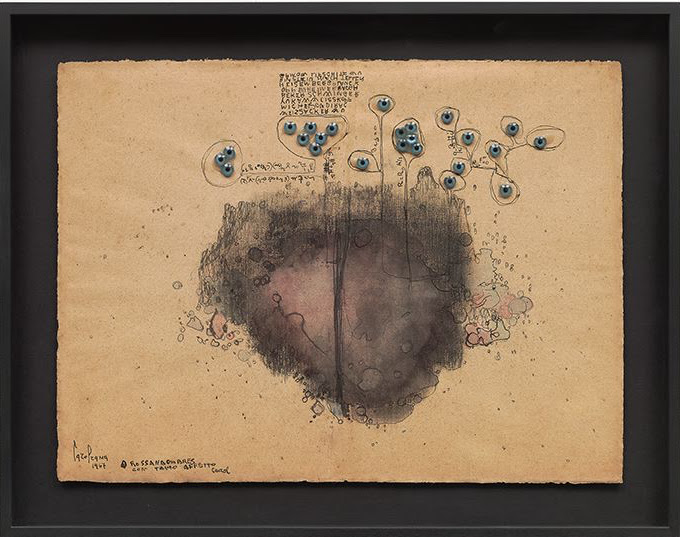CulBeat Express
2019.01.19 00:41
카롤 라마 'Eye of Eyes'@레비고비 갤러리(1/24-3/23)
조회 수 754 댓글 0
LÉVY GORVY TO EXHIBIT WORK BY CAROL RAMA,
ILLUMINATING ENGAGEMENT WITH RICH CULTURAL LIFE OF TURIN
Carol Rama: Eye of Eyes
Carol Rama: Eye of Eyes

January 24 – March 23, 2019
Lévy Gorvy
909 Madison Avenue
New York
Lévy Gorvy
909 Madison Avenue
New York
New York, NY—Lévy Gorvy is pleased to present Carol Rama: Eye of Eyes, an exhibition that expands and enriches narratives attending the work of this remarkable self-taught figure of the Italian avant-garde. Curated by art historian Flavia Frigeri with Valentina Castellani, Eye of Eyes turns to the city of Turin, where Rama was born and lived until her death in 2015. Siting her work in the context of the exhibitions she visited, the artists she was in conversation with, and the formal and conceptual concerns she encountered in the efforts of her contemporaries, the exhibition makes vivid the artistic landscape Rama occupied.
Throughout her seven-decade career, Rama explored the subject of the body as a site of desire and resistance. She employed unconventional and personally significant materials, both organic and industrial, to give form to her idiosyncratic vision. In so doing, she not only defied the orthodoxies of her time and surpassed available critical vocabularies, but she anticipated present-day debates on the aesthetic intersections of sexuality, representation, and power.
It is well-known that Rama rarely left Turin during her lifetime; but as Frigeri here reveals, the city itself opened Rama up to the world. During the artist’s life, Turin became the site of an industrial renaissance centered on the auto industry. As the city’s population diversified to reflect both its legacy of privilege and its active working class, a complex and vibrant cultural community emerged. Famously, this cultural terrain later produced the Arte Povera movement, but it also cultivated a strong network of galleries and institutions that were dedicated to hosting exhibitions by international artists, many of whom would become protagonists of 20th century art. Indeed, Rama counted among her friends such figures as Felice Casorati, Pablo Picasso, Pier Paolo Pasolini, Italo Calvino, and Carlo Mollino.
With assistance from the Rama archives, Frigeri has illuminated Rama’s deeper level of engagement with the art world by identifying the artist’s collection of catalogues for Turin-based exhibitions. These include shows by such artists as Francis Bacon, Hans Bellmer, Alberto Giacometti, Paul Klee, Yves Klein, Meret Oppenheim, Pablo Picasso, Man Ray, and Kazuo Shiraga. At Lévy Gorvy, documentation of these findings guides the viewer through the exhibition.
Among the works on view will be a selection of Rama’s early figurative watercolors, including Opera n. 18 (1939) and Appassionata (1941). Arriving from a raw, youthful perspective, this series of unabashedly sexual images was censored in the artist’s first solo exhibition, at Turin’s Gaber Gallery in 1945. Also featured is a sequence of the artist’s Bricolage works dating from 1964 to 1968. Rama began this series of assemblages on canvas, titled by her lifelong friend, the poet Edoardo Sanguineti, in the 1960s, following her brief engagement with the Milan and Turin-based Concrete Art Movement (MAC). The densely arranged compositions feature such unusual and specific objects as taxidermy and doll eyes, surgical tools, fur, and rifle cartridges. The rubber inner tubes that recur in a related series of abstract, Minimalist works composed throughout the ’70s refer to the artist’s father, who owned a factory that manufactured bicycle and automobile parts. When the artist was 24, her father’s business went bankrupt, plunging her family into poverty and driving her father to commit suicide. The inner tubes and tires, typically cut and flattened by the artist, might resemble flaccid phalluses, or aged skin that has been composed in the language of geometric abstraction.
Considered in the broader context of Turin’s cultural scene, the visionary quality of Rama’s art only comes into greater focus. Working among and in response to her peers, Rama forged an artistic practice that was radical, essential, and ahead of its time.







